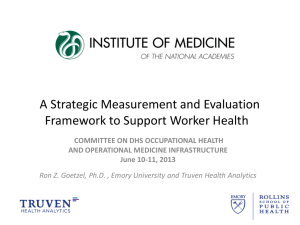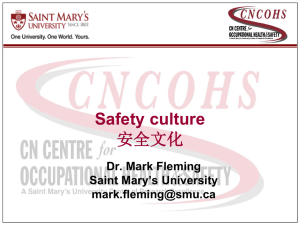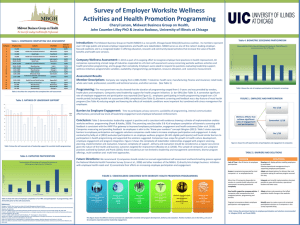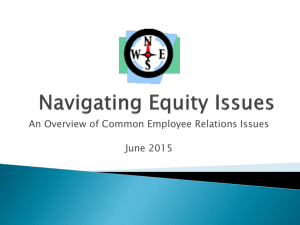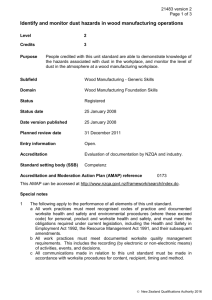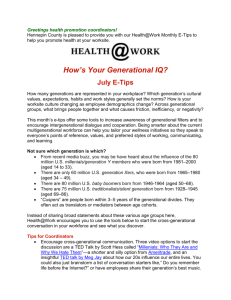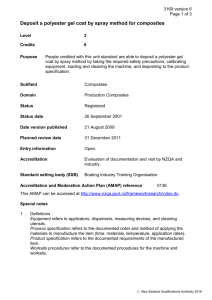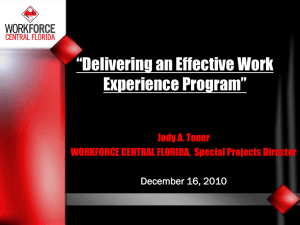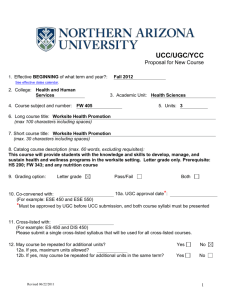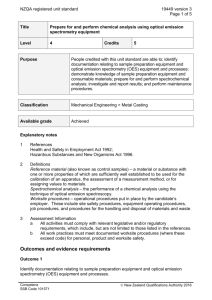Rationale for Worksite Health Promotion
advertisement
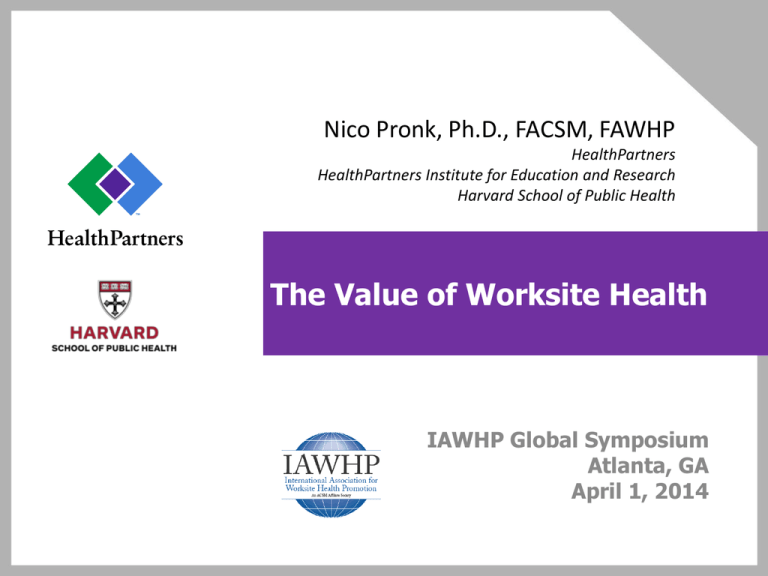
Nico Pronk, Ph.D., FACSM, FAWHP HealthPartners HealthPartners Institute for Education and Research Harvard School of Public Health The Value of Worksite Health IAWHP Global Symposium Atlanta, GA April 1, 2014 Agenda • • • • • • The employers’ perspective The workplace setting Finding value in health Best practices Multiple levels of programming Capturing the value of WHP What About the Employers’ Perspective? • Non-clinical, community-based prevention policies and wellness programs appeal to employers • Importance of family inclusion • Importance of community connection • Company recognition as a leader for health improvement and economic vitality • Recognition that companies and organizations are complex social systems Unsustainable Cost Pressure $41,868 (2021) Health care expenses for U.S. families: 2002-2021 (projected at present growth rate) $38,767 $35,895 $19,393 (2011) $9,235 (2002) $33,236 $30,774 $28,496 $26,384 $24,430 $22,620 $20,944 $18,074 $16,771 $15,609 $14,500 $13,382 $12,214 $11,192 $10,168 2002 2003 2004 2005 2006 2007 2008 2009 2010 2011 2012 2013 2014 2015 2016 2017 2018 2019 2020 2021 Source: 2011 Milliman Medical Index Or to look at it another way… Source: Alliance of Community Health Plans Or to look at it another way… Income: $59,858 Source: Alliance of Community Health Plans Facing the challenges in health care Drivers of health 20% Where money spent Medical services Healthy 30% behaviors Social and 40% economic factors 88% Medical services Where do U.S. health care dollars actually go? 4% Healthy behaviors Physical 10% environment 8% Other The Worksite Setting • Population access – Significant reach into the population – Significant frequency to intervention exposure – Significant access to tools, vehicles, resources, etc. that may be mobilized to increase awareness and PA behavior change – Worksites can identify the population of interest • Employees • Employees and dependents • Targeted subgroups of interest – Interventions can be designed at various levels that interact with the individuals receiving the intervention • • • • Individual Inter-personal Organizational Environmental The Worksite Setting • Work matters for health – Unemployment is a major determinant of health – Worker health may be affected by the organization of work, the policies at work, the relationships at work, etc. • Health matters for work – Chronic conditions may be exclusion criteria for job fit – Fitness for duty tests as indicators of inclusion criteria • Healthy workers and a healthy culture appear to be a good business strategy • Worksite health promotion also is a sound public health strategy and fosters economic growth in the community Broader context Employers recognize the need to: – – – – – – – – – Reduce healthcare spending Reduce illness burden Reduce the likelihood of becoming ill Make healthy choices easy choices Maintain or improve economic vitality Reduce waste Increase longevity Enhance national security Prepare communities for the workforce Workplace Health Works! • AHRF includes both health assessments and biometric screenings • The Task Force finds insufficient evidence to determine the effectiveness of AHRF when implemented alone • The Task Force recommends the use of assessments of health risks with feedback when combined with health education programs, with or without additional interventions, on the basis of strong evidence of effectiveness in improving one or more health behaviors or conditions in populations of workers The value of health ROI Literature Review Systematic review and meta-analysis Conclusion: Worksite Health Promotion programs can generate positive ROI for medical- and absenteeism-related savings: Medical: 3.27 : 1 Absenteeism: 2.73 : 1 The value of health 16 Impact of obesity on work limitations is akin to 20 years of aging 14 12 10 8 6 4 2 0 Normal Weight Overweight Ob ese Source: Hertz, et al. JOEM 2004; 46:1196-1203. 20-39 40-59 60+ 1.9 3.6 8.4 2 3.6 8.1 4.1 8 14.5 Value through design Companies across a variety of industries report benefits: • Lower health care costs • Greater productivity • Higher morale ROI can be as high as 6:1 Six Essential Pillars for Successful Programs: 1. Engaged leadership at multiple levels 2. Strategic alignment with the company’s identity and aspirations 3. A design that is broad in scope and high in relevance and quality 4. Broad accessibility 5. Internal and external partnerships 6. Effective communications Best Practice Design Principles 9 Best Practice Dimensions • Leadership • Relevance • Partnership • Comprehensiveness • Implementation • Engagement • Communications • Data-Driven • Compliance Why then, such confusion? • Confusion over the definition of a worksite health/wellness program – Population-based • Even people with diagnosed disease retain access to lifestyle behavior change programs • Disease and lifestyle management programs are artificially segregated into siloes • Value of worksite health programs goes far beyond medical care cost savings • Even this article showed a positive ROI for the whole program ($1.46:1) Environment shapes behavior Abnormal reaction to a normal environment? A normal reaction to an abnormal environment? Individual decision do matter! Choices for interventions Cardiovascular disease, diabetes, cancers, lung disease…Preventable deaths Obesity, lack of fitness, high blood pressure, high cholesterol, high blood sugar Tobacco use, poor diet, lack of physical activity, excessive alcohol use Environments – physical, psychosocial (culture), socioeconomic Social policy, community mobilization Making healthy choices easy choices Individual Effort Health Potential Environmental (physical, psychosocial) and Policy Interventions (Public, organizational, etc) Source: Pronk NP, Kottke TE. Health Promotion in Health Systems. In: Rippe, J. Lifestyle Medicine, 2013. Moving Beyond Available Evidence • Evidence of what works needs to be applied in the context of the workplace environment • Inflexible focus on program fidelity may limit adoption of programs with sustained success • Practice-based evidence can only be generated if solutions are successfully implemented • Worksite health programs will only deliver on their promise when supported as a business strategy with leadership support and accountability Comprehensive, Multi-Level, Multi-Component Programming Make Being Healthy and Productive… Possible Simple Socially rewarding Financially rewarding Personally relevant Organizationally relevant Levels of Influence Individual Interindividual Exceptional Customer and User Experience Organizational Environmental Outcomes Source: Pronk, NP. Journal of Physical Activity and Health, 2009, 6 (Suppl. 2), S220-S235. Health Productivity Financial / ROI Community connected Valuing Workplace Health i.e., Worksite Valuing – What should be counted? Benefits and Harms Comprehensive assessment Health Benefits -----------Harms Community Well-Being Benefits -----------Harms Community Well-Being Indicator Community Process Benefits -----------Harms Community Process Indicator Comprehensive assessment QALYs or HALE Community Benefit Value The value of an intervention considers its benefits, harms, and costs. Resources Used Valuing – What should be counted? Identification of Investments and Resources Savings ----------Costs Monetary Units (USD) Community Cost i.e., Worksite What Does “Success” Look Like? Risk transitions based on HA-derived risk levels among employees over 2 years (N=1,087) Doing nothing may reduce the population’s health by as much as 7% per year 21% 66% Got Better 36.3% 14.4% Baseline 24% Moderate Risk 13.2% 33.5% 15.1% 2.5% Baseline 24% High Risk Net population health improvement of 8%. Baseline 7% Disease: Well Managed 25.0% 1.3% Baseline 1% Disease: Poorly Managed 0.2% 0.8% 4.5% 87% did not get worse Source: HealthPartners Health Assessment Database, 2011 Got Worse Stayed the Same Baseline 44% Low Risk Soource This 2-year health and well-being program was associated with a ROI of 2.9:1 13% Conclusions • When workplace health and wellness programs are implemented according to best practice principles of design, significant value may be generated • Valuation models should go beyond traditional ROI and capture those “values” that are relevant to the company Thank You!
